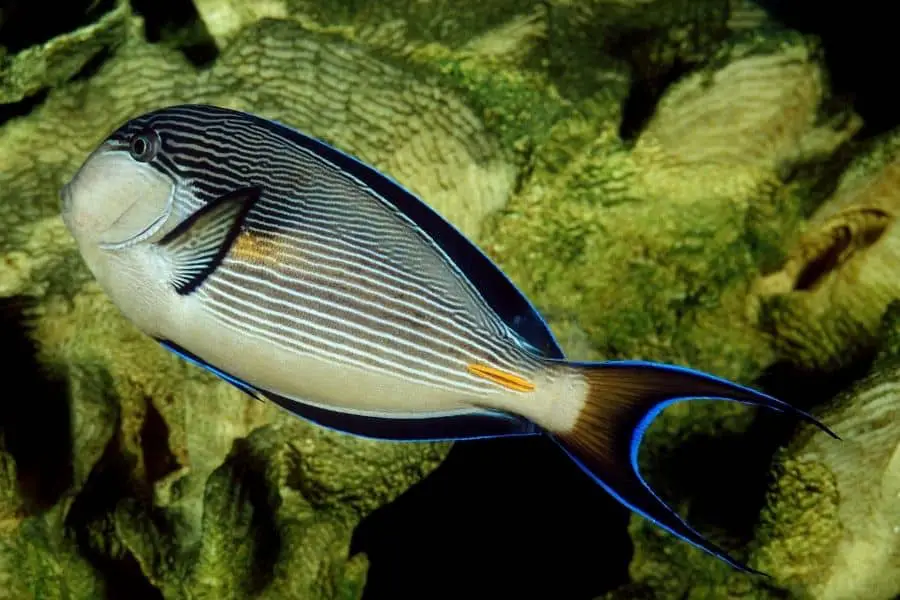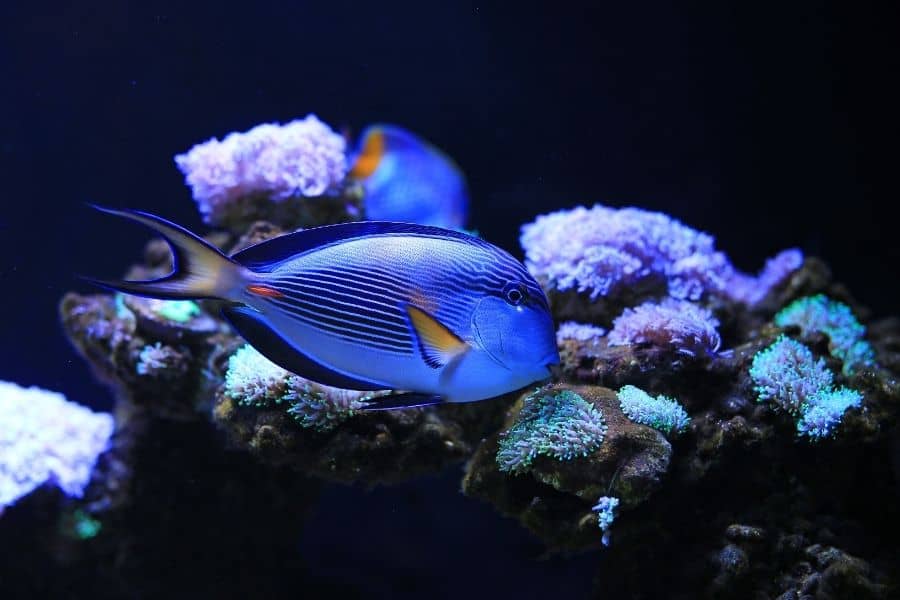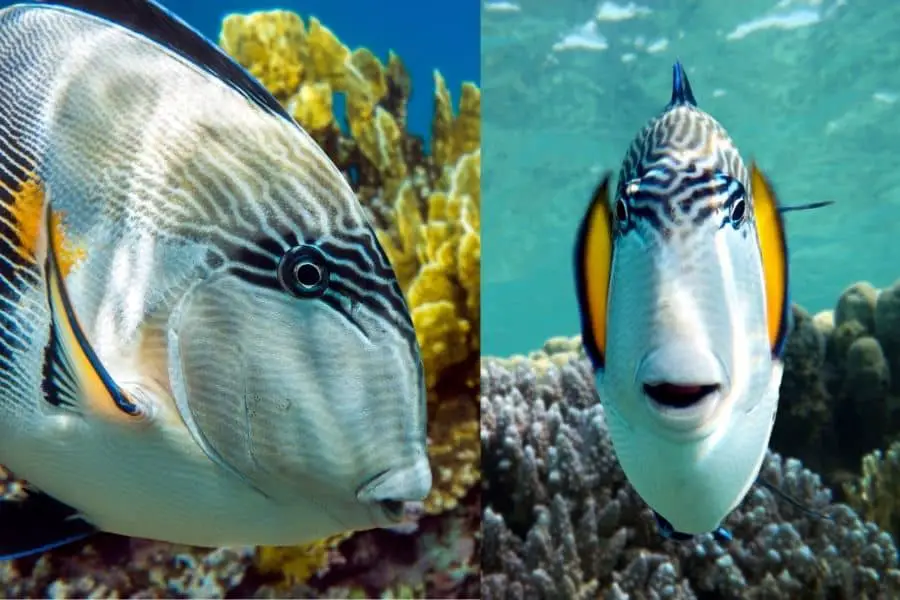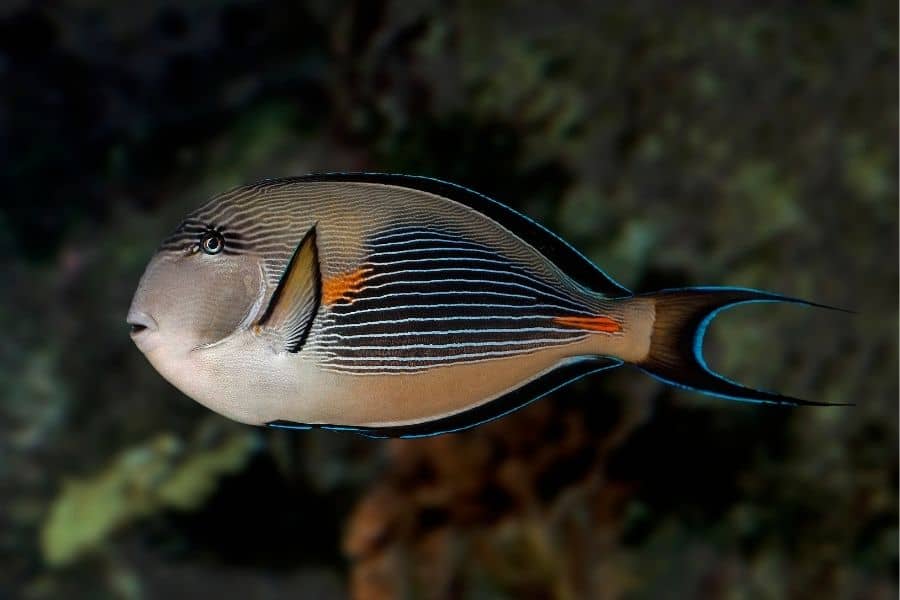The seabed is another type of beautiful world where thousands of marine creatures such as Sohal Tang. Sohal Tang fish is one of the popular varieties of Tang fish. Like other tangs, Sohal tangs have body colors and patterns which are unique to them. So, today I am going to update your knowledge about one such fish variety called Sohal Tang. I invite you all to join and get to know all the interesting facts about the Tangs.
They are very large in size, active, and aggressive types of fish. The possibility of keeping Sohal Tangs in an aquarium depends on various factors. They need large amounts of necessary nutrients in their diet, adequate water quality conditions, and more space to swim in the aquarium. The selection of the tank mates is also a critical factor in the Sohal fish aquarium. If these factors are at a favorable level, keeping Sohal fish in an aquarium is not a problem.

One Look Care Guide
Jump To
- 1 One Look Care Guide
- 2 Sohal Fish Natural Habitat
- 3 The Appearance of Sohal Fish
- 4 Tank requirements
- 5 How to care Sohal Tang Fish
- 6 Are Sohal tangs fish reefs safe?
- 7 How do sohal tangs reproduce?
- 8 Is it possible to breed Sohan Tangs in Captivity?
- 9 How fast do Sohal Tang Grow?
- 10 What do Sohal Tangs Eat?
- 11 Predators of the Sohal Tang
- 12 Why are Sohal Tang Dying?
- 13 Are Sohal Tang Aggressive?
- 14 Sohal Tang Tank Mates
- 15 Are Sohal Tanks prone to Diseases?
- 16 How to Protect Sohal Tangs from Diseases?
- 17 Tang Types and Colors
| Scientific name | Acanthurus sohal |
| Common name | Sohal surgeonfish, Sohal tang |
| Care level | Moderate |
| Reef Compatible | Yes |
| Native to | Red Sea |
| Type (soft or hard coral) | Hard |
| Color | Black, Blue, Green, Yellow |
| Tank size | 250 gallons or more |
| Preferred temperature | 72-78° F |
| Preferred pH | 8.1- 8.4 |
| Other water parameters | Ammonia : Zero (0 ppm) Nitrates : Zero (0 ppm) Nitrites : Zero (0 ppm) |
| Prefered salinity | 1.023 – 1.025 specific gravity |
| Size | 14 to 16 inches |
| Growth rate | 4 inches growth less than a year |
| Temperament | Semi-aggressive |
| Recommended tank mates | Tusk fish Large fish types like Angelfish Triggerfish |
| Preferred food | Microalgae Herbivore pellets Frozen herbivore formulations Dried marine algae Spirulina-based commercial foods Sushi nori Red marine algae Vegetables like Lettuce, Peas and Spinach |
| Feeding frequency | A well-balanced diet 3 or 4 times per day |
| Propagation by | External fertilization, Broadcast spawning |
Sohal Fish Natural Habitat
Sohal fish are a very diverse group of reef fish. Mostly available in shallow marine reefs throughout the Western Atlantic Ocean, Caribbean Sea, Gulf of Mexico, and Western Indian Ocean. They are very common from the Red Sea to the Persian Gulf in the Indian Ocean.
The Appearance of Sohal Fish
Sohal fish have interesting laterally compressed and ovoid-like shapes in general. It exhibits straight, horizontal, and alternating light and dark colored stripes on its flanks and head. There is a beautiful wavy look around the head. The pelvic, dorsal, and anal fins of the Sohal fish are black. The pectoral and caudal fins are yellow.
All the fin margins are attractive with a neon blue color. The “scalpel” on the caudal peduncle is capable of inflicting tankmates and other external bodies. It is highlighted in orange color. so you should be careful when handling them in the aquarium. The maximum size for the Sohal Tang species is around 16 inches. So you can see that is a big fish.

Tank requirements
Size of the tank
Sohal Tang fish is a very large and aggressive fish type. Therefore, they must be housed using proper techniques. Always select large-size fish tanks with more space inside, to house Sohal Tangs. Because Sohal tanks are larger and more aggressive they need considerably large space. Also do not forget to place sufficient live rock or another type of cover to separate Sohal Tangs from other fishes. Hence Sohal tangs should be kept in a tank of 240 gallons or larger and an 8-foot-long tank.
Water Salinity
Sohan Tangs are marine fish and need saline water to live. Saltwater can be prepared by mixing aquarium salt into the water. The recommended ratio to mix salt and water is one-half cup of salt per one gallon of water. The appropriate salinity for the saltwater fish is between 1.023 and 1.025 (specific gravity). Hence get the salinity of the mixture up to that level. Salinity below 1.027 is not safe for the fish’s health. So, always use a salinity meter to monitor salinity levels in the water.
Water hardness
Water hardness means the amount of dissolved calcium and magnesium ions in the water. The hardness level suitable for tang fish is about 420 ppm. You should test the hardness levels once every week. Acceptable levels for the water hardness in aquariums with reefs are between 380-450ppm.
Oxygen
Sohal Tang Fish need oxygen in their water to survive. Therefore, the tank water should have a good level of dissolved oxygen. So it is essential to use aerators and water filters help to distribute more oxygen into the tank water. To maximize oxygen availability you can use an aquarium with wide tops to allow more oxygen to enter from the surface. Also, high-quality pumps, air stones, and plants can be a nice addition. Less fish in the tank also increases the oxygen level of the tank.
Water Filtration
When the Sohal Tangs are in the sea, the water is circulating. But the aquarium water is not moving. Because of this toxic waste build up in the tank. So, toxic water may cause harm to the Sohal Tangs. Therefore, tank water must be filtered often enough. Further, the filter should be washed and cleaned once a week. Biological filters can be used to clean and filter the tank water. Also using wave makers in these tanks can improve water circulation and mimic a marine environment in your fish tank.

How to care Sohal Tang Fish
- The most important factors you should consider when caring for Sohal Tang fish are adequate space, feed, and proper tankmate selection.
- Simply Sohal Tangs grow upward of 16 inches. Usually, they eat a lot of food.
- Provide a live rock to graze them all over the day. Sohal Tangs need a varied diet consisting of marine seaweeds, algae, and plant materials.
- Provide other food supplements to get maximum nutritious levels. Spirulina-based commercial foods with green leaf lettuce provide Sohal Tangs, with a well-balanced diet.
- All these foods inside the tank create a high bioload. Therefore, make sure the water filtration system works properly in the aquarium.
- Sohal Tangs need a medium of strong water currents and large open swimming areas inside the tank.
- Sohal Tangs are a very active and aggressive form of tangs. Therefore, they need a large swimming area to swim.
- Sohal Tangs are a very dominant and aggressive species of fish. Hence house them with a suitable large fish species who can hold their territory.
Are Sohal tangs fish reefs safe?
Yes, they are reef safe because they do not disturb corals. Their aggressive behaviour does not bother invertebrates as well.
How do sohal tangs reproduce?
Sohal Tangs reproduce through a method known as “broadcast spawning”. It is a form of sexual reproduction method used by many aquatic invertebrates. In this, sexually matured females release eggs, and males release sperms into the open water at the same time for “external fertilization”. It means the sperm fertilizes an egg in the open water, outside the female’s body. This method increases the possibility of eggs becoming fertilized successfully. It ensures that the fertilized eggs will not be eaten by predators on the reef surface.
Related: Sea bunny | Facts You Must Know
Is it possible to breed Sohan Tangs in Captivity?
No. Sohal Tangs cannot be bred in captivity. Because it is difficult to keep more than one Sohal Fish in the same tank. Therefore, Sohal Tang breeding is difficult.
How fast do Sohal Tang Grow?
- Sohal Tangs show about 4 inches growth rate in less than a year. But many factors determine the growth rate of Sohal Tang fish.
- They grow fast when you feed them well. Therefore, feed them 3 to 4 times per day.
- Keep stress factors out.
- Be careful when selecting tank mates to the Sohal Tang fish aquarium.
- Give them more space to swim in the tank.
- Check water quality conditions and water filtration in the tank regularly and maintain favorable levels.
Related : Vlamingi Tang Unicorn In The Sea | Care Details You Must Know
Related : Clown Tang (Acanthurus lineatus) Marine Fish Care Guide
What do Sohal Tangs Eat?
The Sohal Tangs only eat plant-based foods. Most commonly sohal Tangs graze the microalgae of the ocean reefs and rocks. They prefer to eat algae-based foods such as,
- Herbivore pellets
- Frozen herbivore formulations &
- Dried marine algae
The sushi nori or red marine algae which are sold like sheets are some examples of dried marine algae. Also, sohal Tangs eat commercial plant-based foods like spirulina-based commercial foods. They also like to eat high-quality flake and pellet foods.

How to feed Sohal Tangs ?
It is not a difficult process. Get spirulina-based commercial foods from the market. Add Nori sheets into the mix. To increase the nutrient level soak the diet in a blend of supplements. Vegetables like Lettuce, Peas and Spinach can also be added to the diet. Do not forget to add a protein source to make the diet balanced. Although tangs are herbivores, they prefer protein like Mysis and Brine shrimp to mix with their feed. Shrimps fulfill the protein and vitamin needs of the feed. Moreover, Sohal Tangs accept high-quality flakes and pellets as their food.
Important fact: It is a challenge for the Sohal Tangs to find food in aquariums. The reason is the Sohal Tangs mainly eat algae. But in the community tank, other algae-eating fish will compete over the natural food that is available in the aquarium. Therefore, you need to supply food from outside.
Feeding Frequency
Sohan Tangs need a nutritious diet to live healthily. Therefore, you need to feed them a well-balanced diet 3 or 4 times per day.
After Feeding
After feeding, do not forget to remove excess food from the tank. Otherwise, it may deposit in the tank bottom and spoil the water. Fish may get stressed as a result.
Predators of the Sohal Tang
The main predators of Sohal Tangs are large carnivorous fish. They include,
- Barracuda
- Tuna
- Groupers
- Snappers
Sohal Tang got a sharp “scalpel” as a defense organ against predators.
Why are Sohal Tang Dying?
In a natural habitat, Sohal Tangs can live up to more than 15 years. In an aquarium under the ideal care conditions and water quality conditions, they can live an average of 10-15 years. If the fish dies earlier than that, it is considered an early death. There are many reasons responsible for the early age deaths of Sohal Tangs.
Main reasons
- When the fish are in captivity they may be subject to stress. Stress causes less appetite for feeding. Less nutrition intake might cause diseases and lead them to death.
- Sohal tangs often require a fully cycled saltwater aquarium with maximum recommended water quality conditions.
- If ammonia, nitrates, or nitrites level is high in aquarium water their stress level will climb up. Stress may cause disease and lead them to death.
Are Sohal Tang Aggressive?
Sohal Tangs can be a very aggressive type of fish. Hence, they should not be kept with other Tangs. They behave friendly with old tank mates. But when you add new fish to the tank, they can be very aggressive. Because of this reason, very large aquariums are recommended to house Sohal Tangs.
Sohal Tang Tank Mates
Selecting tank mates for Sohal Tangs is considered as the most difficult part of keeping the Sohal Tang aquarium. The reason is they are not nice to other Tang types. As a solution for this, it is advised to introduce Sohal fish at last to the aquarium. Because they do not bother older fish that are already in the tank. If you want to keep other tankmates with Sohal Tangs you can place aggressive types of fish such as;
- Tusk fish
- Large fish types like Angelfish
- Triggerfish
Important tips
For large aquariums, it is alright to introduce both young Sohal Tangs and other young fish at the same time. Sohal tangs will grow up in their own space in the aquarium. But it is too risky on one hand. We cannot guarantee the behaviour of Sohal Tangs because they are not friendly to other types at all.
Are Sohal Tanks prone to Diseases?
Not always. But the most common disease Sohal Tang gets is the “Lateral Line Erosion”. Fish can develop tiny, pitted holes that start around the eye due to this. This is caused due to poor water quality and improper diet. This is not a fatal disease and can be cured.
How to Protect Sohal Tangs from Diseases?
Important fact: Before introducing newly purchased Sohal Tangs into the tank, quarantine them.
- Dip them in the freshwater of the quarantine tank. The salinity of the water in the quarantine tank should be low.
- The reason is it will kill the parasites on the body of the Sohal Tangs.
- Then add fish into the separate quarantine tank that has 1.013-1.015 salinity level.
- Allow them to live in a quarantine tank for 1-2 weeks.
- When the fish is fully quarantined introduce them to the aquarium
Additionally.
- Get an aquarium of more than 180 gallons (700 Liters) size.
- Maintain strong water movement and place live rock structures inside the tank.
- Add Sohal Tangs last to the tank. This is due to the aggressive and constant roaming nature of the fish.
- The Diet of the Sohal Tangs should consist primarily of Algae or vegetable matters.
- “Sushi Nori” can also be the main diet of this fish.
- In addition, the diet should be supplemented with a variety of frozen Mysis shrimps or other similar food items.
- They are constant grazers who scrape off marine algae in the aquarium.
- Therefore, I recommend feeding them several times a day. This will ensure that Sohal Tangs get the necessary nutrient content.
Tang Types and Colors
Tangs are also called Surgeonfish. When it comes to the colors, Tangs cover the colors of the entire rainbow. Usually, the name of the Tang comes with the color of their body. Following colors are popular among the tangs.
- Yellow
- White
- Blue
- black
Most of the Tangs got scales, patches and stripped like patterns in their body. The sizes of the Tangs are varied within the group.
- The minimum length of the Tang is 20 cm (8 inches).
- The maximum length usually does not exceed 50 cm (20 inches).
The sizes of other Tang groups are in between that.
Achilles Tang
Achilles Tangs are found in the Pacific Ocean. They got black scales and an orange patch near the tails. They are 10 inches in size. The preferred tank size for the Achilles tangs is 120 gallons. Achilles tangs are aggressive and difficult to grow in an aquarium. They are highly susceptible to every tang illness. When they are in the tank Achilles Tangs easily get stressed due to the presence of large carnivore fish.
Brown Tang/Brown Surgeonfish
Brown Tangs are also called Lavender tangs. They can be found in the South Pacific Ocean. The length of the fish is about 3 to 8 inches. They are one of the smallest in the group. Brown Tangs are super active and can swim fast throughout the tank. Even though they pick fights with others, still they can be paired with other tangs. Therefore, they are the most peaceful group among the tangs. Brown Tangs are semi-aggressive and easy to keep in the tank. The preferable tank size is 55 gallons.
Clown Tang
Clownfish are found in Indo Pacific Oceans. They can grow up to 14 inches. They are blue and have a yellow striped pattern on the back. People love to add them to a reef tank. But it is not easy due to the large size. You will need at least a 180 gallons tank to house one of these clowns safely. Clown Tangs are aggressive and moderately difficult to grow in a fish aquarium. You will need some experience to handle the fish due to its aggression. It is a bit difficult to transport clowns from one place to another. They do not always survive after transportation. Clowns are fine once they get established in a tank.
Fowleri Tang
Fowleri tangs are also called Horseshoe surgeonfish or black spine surgeonfish. Tang is found in the Indonesian sea and one of the largest members of the tang family. They reach up to 18 inches when fully grown. F Tangs bear flowing tail of yellow and white. The color of the body is grey, brown with blue and gold accents on the fins. The sweet-tempered nature makes them unique from other Tang varieties. The long tail might give them a graceful quality that you do not see in other members. But you need a very large tank to grow them. The size of the tank is 300 gallons. It is moderately difficult to grow them in an aquarium.
Lemon Tang/Mimic Lemon Peel Tang
Lemon tangs have brilliant yellow color from juvenile to adult stage. It is the most attractive feature of them. They also tolerate other tang species. Therefore, you can consider mixing them with a different Tang variety. In the wild, they can found in Indonesia and Fiji Islands. Lemon Tangs are 10 inches in size. Lemon tangs are active swimmers. Hence, you need to provide them with an open swimming space as much as possible. They need a tank of 150 gallons in size. Inside the tank, you should keep live rock and caves. They are semi-aggressive and easy to grow in an aquarium.
